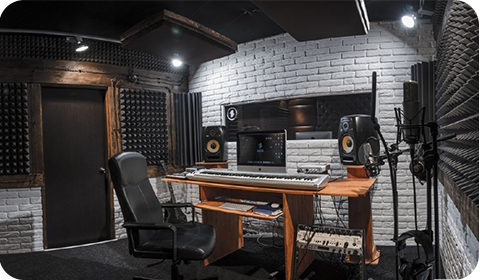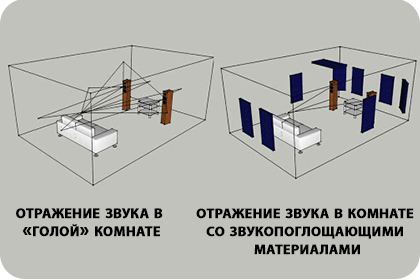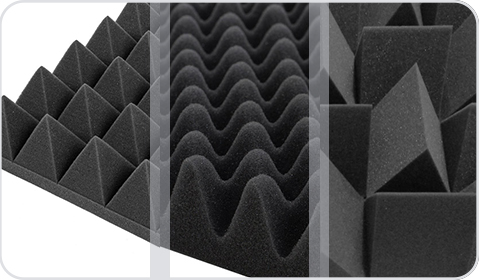 Recording Studio is one of those areas for sound insulation which must be approached responsibly. After all, for its effective functioning need to take care of sound insulation and sound absorption in the room. Well, if we talk quite simple, the external noises must remain on the street, inside noises stay indoors and not to disturb the neighbors.
Recording Studio is one of those areas for sound insulation which must be approached responsibly. After all, for its effective functioning need to take care of sound insulation and sound absorption in the room. Well, if we talk quite simple, the external noises must remain on the street, inside noises stay indoors and not to disturb the neighbors.
Two important factor of proper operation of such facilities:
Lock the Studio from contamination of air and structural noise. For this task you need to do the soundproofing. For rooms such format apply the methodology of integrated insulation "floor-wall-ceiling". Concrete is no solution, it is chosen individually in each case. But definitely need to start from the floor. If the screed is laid sound-absorbing material. It can be: "Acuflex" chemically cross-linked polyethylene or plate based on glass "Aquaflor-S20". The latter, incidentally, are working not only impact noise but also air. For protection against vibrations and for ventilation equipment used materials such as Sylomer, Tecsound, Vibrofix.
Next is soundproofing the ceiling. Do it frame or frameless way. Materials you can use: panels ZIPS, membrane Tecsound necessarily in combination with wool (how to select it, you can read this article). In the end everything is closed gypsum Board or gypsum fiber Board. For soundproofing walls or use panels ZIPS (mounting directly to the wall) or membrane Tecsound on the same principle as with the ceiling.
To create in the Studio favorable acoustical climate will help the acoustic correction of the room. And in this article we will talk about what materials to reach her and how to do it.
Let's look at why correction of room acoustics? Sometimes, among novice sound engineers are of the opinion that it's all a marketing ploy to make more money to invest in the Studio, the main thing - the equipment is modern. But it is not! Ignoring the correction of the acoustics, the first thing You encounter when recording sound it is: lame sound, low quality recording music and voice files, noise pollution, and for dessert - the effect of a terrible echo. Not very promising, isn't it?
 To remove these effects, it is necessary to use porous materials which have the effect of sound absorption and dispersion of sound. How does it work? Noise, in fact, is in the amount of two or more sound waves. They can both be absorbed and reflected. If the wall is "naked" (no sound-absorbing materials) the wave is reflected and starts to maneuver between obstacles – so we get the echo. To reduce the effect of wave furniture (soft) or carpets. Yes, Yes, when they all hung on the wall colorful "sound absorbers". But we live in the 21st century, and carpet is no longer listed, so long ago invented a special acoustic foam.
To remove these effects, it is necessary to use porous materials which have the effect of sound absorption and dispersion of sound. How does it work? Noise, in fact, is in the amount of two or more sound waves. They can both be absorbed and reflected. If the wall is "naked" (no sound-absorbing materials) the wave is reflected and starts to maneuver between obstacles – so we get the echo. To reduce the effect of wave furniture (soft) or carpets. Yes, Yes, when they all hung on the wall colorful "sound absorbers". But we live in the 21st century, and carpet is no longer listed, so long ago invented a special acoustic foam.
Foam refers to environmentally friendly materials. Its density should be 25-35kg/m3. By the way, the smaller it is, the better the sound absorption. It is suitable for rooms even with high level of humidity and its service life up to 25 years. The foam has an open cell structure if the drop on him a couple of drops of water, it will absorb, the same happens with sound waves.
Foams are of two types:
- for low frequencies ("bass traps")
- for medium and high frequencies (sheet and roll materials). It can be baseley or relief: "wave", "pyramid", "aura".
Often, for the Studio to the wall glue the pyramid, and on the ceiling "wave". The crown of foam depends directly on its effect. Since the "wave" gives as soft sound-absorbing effect. They can be papered all the walls and the ceiling.

But the "pyramid" gives a result when you slice it you use in certain areas of the room (calculated individually for each room). They often fill the space in the speakers, the subwoofers. As it improves the sound of sound waves of medium and high range.
Standard color of foam black, but under the order can be made in any color. Online available foams from 0.5 - 10cm. Choosing the thickness you need, remember the rule: "the higher noise level, there needs to be a thicker foam". It can be fastened with a construction stapler, special adhesive strips, acrylic adhesive, textile adhesive tape or liquid nails on acrylic base.
Talk in detail about "bass traps". They are used for low frequencies from 20 Hz, namely: supplements imbalance, control the acoustics, reducing resonance. Set them in corners, because that is where accumulate low frequencies. So the trap can absorb sound waves and their correct arrangement changes the geometry of space (which the exception of the angle of 90º), which positively affects the quality of sound and its dispersion. "Bass traps" are reliefs: "Saw" (angular, of varying thickness and length) and the Cube.
The result of this so as not to disturb the neighbors while recording high quality sound without extraneous noise, it is necessary to use various measures of sound insulation. Soundproofing a recording Studio – is, first of all, a sound approach to business.
If You have any questions, please contact:
 (067) 504-38-12
(067) 504-38-12
